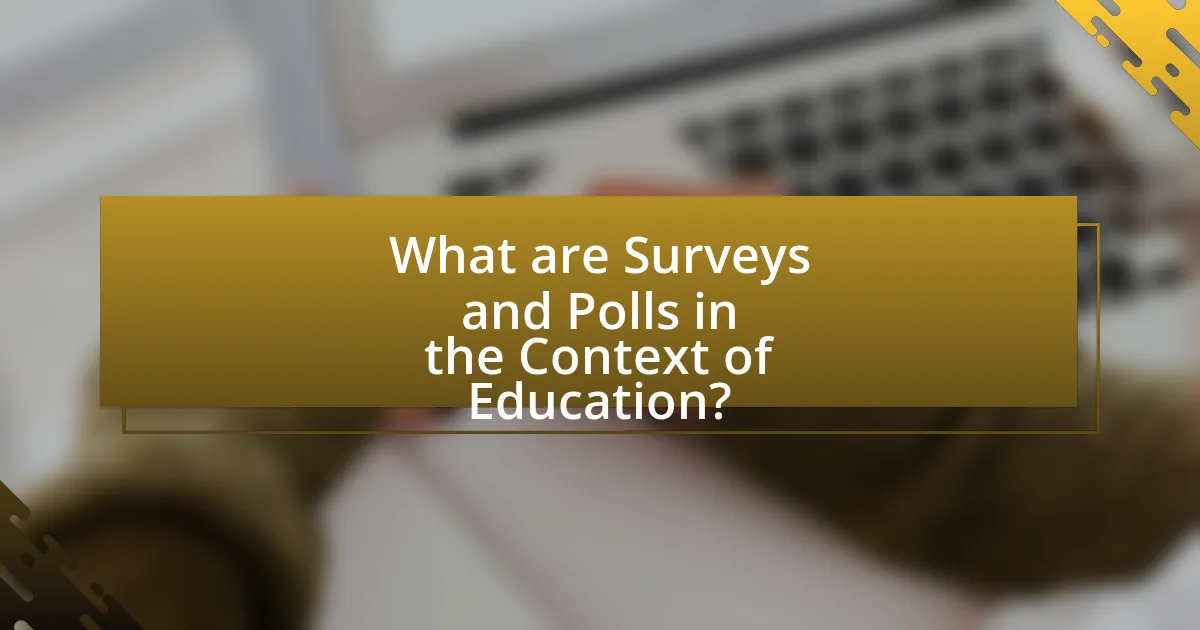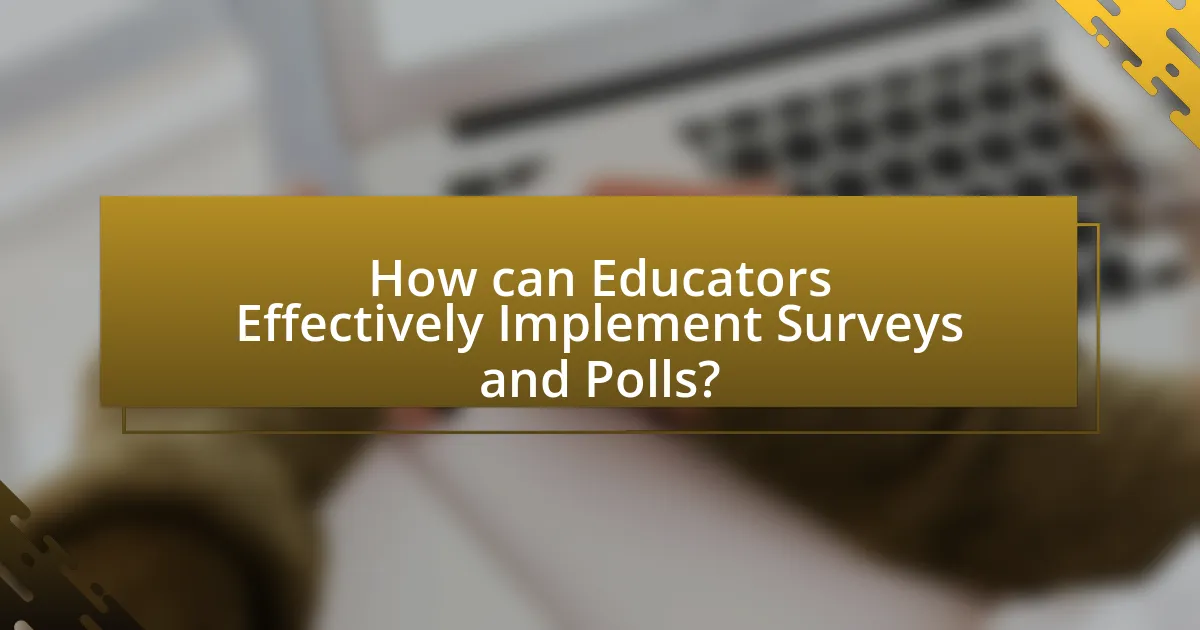Surveys and polls are essential tools in education for collecting data on student opinions, preferences, and needs, which inform decision-making and curriculum development. The article explores the differences between surveys and polls, detailing their applications, types, and methodologies used in educational settings. It emphasizes the importance of gauging student interests and needs to enhance engagement and improve educational outcomes, while also discussing best practices for conducting surveys and polls effectively. Additionally, the article highlights the benefits of utilizing these tools, including increased student participation and informed teaching strategies, as well as the challenges educators may face in implementation.

What are Surveys and Polls in the Context of Education?
Surveys and polls in the context of education are tools used to collect data on student opinions, preferences, and needs. These instruments enable educators and administrators to gather quantitative and qualitative information that can inform decision-making, curriculum development, and resource allocation. For instance, a survey might ask students about their preferred learning styles or subjects of interest, while a poll could gauge immediate feedback on a specific lesson or program. Research indicates that utilizing surveys and polls can lead to improved student engagement and satisfaction, as they provide a platform for students to voice their thoughts and contribute to their educational experience.
How do surveys and polls differ in their application for gauging student interests?
Surveys and polls differ primarily in their depth and scope when gauging student interests. Surveys typically consist of a series of detailed questions designed to gather comprehensive data on various aspects of student preferences, allowing for nuanced analysis. In contrast, polls are generally shorter and focus on obtaining quick, snapshot responses to specific questions, often yielding immediate insights into student opinions. For example, a survey might explore multiple facets of student engagement in extracurricular activities, while a poll might simply ask students to choose their favorite activity from a list. This distinction highlights that surveys provide richer, more detailed information, whereas polls offer rapid feedback on specific issues.
What types of surveys are commonly used in educational settings?
Commonly used surveys in educational settings include student satisfaction surveys, course evaluations, needs assessments, and climate surveys. Student satisfaction surveys gather feedback on the overall educational experience, while course evaluations assess specific classes and instructors. Needs assessments identify gaps in resources or support, and climate surveys evaluate the overall school environment. These surveys are essential for improving educational quality and addressing student needs effectively.
What types of polls are commonly used in educational settings?
Common types of polls used in educational settings include formative assessments, satisfaction surveys, and opinion polls. Formative assessments, such as quizzes and exit tickets, help educators gauge student understanding and adjust instruction accordingly. Satisfaction surveys collect feedback on courses, teaching methods, and resources, allowing institutions to improve the educational experience. Opinion polls solicit student perspectives on various topics, fostering engagement and participation in decision-making processes. These polls are essential tools for understanding student needs and interests, ultimately enhancing educational outcomes.
Why is it important to gauge student interests and needs?
Gauging student interests and needs is crucial for tailoring educational experiences to enhance engagement and learning outcomes. When educators understand what students are passionate about and what challenges they face, they can design curricula and activities that resonate with students, leading to increased motivation and participation. Research indicates that when students feel their interests are acknowledged, their academic performance improves; for instance, a study published in the Journal of Educational Psychology found that student engagement significantly correlates with interest-based learning approaches. Therefore, assessing student interests and needs directly contributes to creating a more effective and responsive educational environment.
How does understanding student interests impact educational outcomes?
Understanding student interests significantly enhances educational outcomes by fostering engagement and motivation in learning. When educators align curricula with students’ interests, they create a more relevant and stimulating learning environment, which can lead to improved academic performance. Research indicates that students who are engaged in their learning process are more likely to retain information and develop critical thinking skills. For instance, a study published in the Journal of Educational Psychology found that students who participated in interest-based learning activities showed a 30% increase in retention rates compared to those in traditional settings. This correlation underscores the importance of utilizing surveys and polls to gauge student interests, as it allows educators to tailor their teaching strategies effectively, ultimately leading to better educational outcomes.
What role do student needs play in curriculum development?
Student needs are fundamental in curriculum development as they ensure that educational programs are relevant and effective. By assessing student interests and requirements through surveys and polls, educators can tailor the curriculum to address specific learning goals and preferences. Research indicates that when curricula align with student needs, engagement and academic performance improve significantly. For instance, a study by the National Center for Education Statistics found that students who feel their educational content is relevant to their lives are more likely to succeed academically. Thus, incorporating student needs into curriculum development not only enhances learning experiences but also fosters a more inclusive educational environment.
What methodologies are effective for conducting surveys and polls?
Effective methodologies for conducting surveys and polls include online surveys, telephone interviews, and face-to-face interviews. Online surveys, such as those conducted through platforms like SurveyMonkey or Google Forms, allow for quick data collection and can reach a broad audience efficiently. Telephone interviews provide a personal touch and can yield higher response rates, especially when targeting specific demographics. Face-to-face interviews facilitate in-depth discussions and can uncover nuanced insights that other methods may miss. Research indicates that mixed-method approaches, combining quantitative and qualitative data, enhance the reliability and validity of findings, as demonstrated in studies like “The Effectiveness of Mixed Methods in Survey Research” by Creswell and Plano Clark, which highlights the strengths of integrating various methodologies for comprehensive data analysis.
What are the best practices for designing effective surveys?
The best practices for designing effective surveys include clearly defining the survey’s objectives, using concise and straightforward language, and ensuring a logical flow of questions. Clearly defined objectives guide the survey design, ensuring that questions align with the information needed. Concise language minimizes confusion and increases response rates, as evidenced by studies showing that simpler wording leads to higher comprehension and engagement. A logical flow helps respondents navigate the survey easily, which can improve completion rates; research indicates that surveys with a coherent structure yield more reliable data. Additionally, incorporating a mix of question types, such as multiple-choice and open-ended questions, can provide both quantitative and qualitative insights, enhancing the depth of understanding regarding student interests and needs.
How can technology enhance the polling process in education?
Technology can enhance the polling process in education by facilitating real-time data collection and analysis. Digital tools such as online survey platforms enable educators to quickly gather student feedback through anonymous polls, increasing participation rates. For instance, a study by the University of Michigan found that online surveys can yield response rates of over 70%, significantly higher than traditional paper methods. Additionally, technology allows for immediate data visualization, helping educators to interpret results swiftly and make informed decisions to address student needs effectively.

What are the Key Benefits of Utilizing Surveys and Polls?
The key benefits of utilizing surveys and polls include the ability to gather quantitative and qualitative data, enhance decision-making, and improve engagement. Surveys and polls provide a structured method for collecting feedback, allowing institutions to understand student interests and needs effectively. For instance, a study by the National Center for Education Statistics found that institutions using surveys to assess student satisfaction can increase retention rates by up to 10%. This data-driven approach enables targeted improvements in programs and services, ultimately fostering a more responsive educational environment.
How do surveys and polls contribute to student engagement?
Surveys and polls significantly enhance student engagement by providing a platform for students to voice their opinions and preferences. This active participation fosters a sense of ownership and belonging within the educational environment. Research indicates that when students feel their feedback is valued, their motivation and commitment to learning increase, leading to improved academic performance. For instance, a study published in the Journal of Educational Psychology found that students who participated in feedback surveys reported higher levels of engagement and satisfaction with their courses. Thus, the implementation of surveys and polls directly correlates with heightened student involvement and a more responsive educational experience.
What evidence supports the link between surveys and increased student participation?
Surveys significantly increase student participation by providing a platform for students to express their opinions and preferences. Research conducted by the National Survey of Student Engagement (NSSE) indicates that institutions that actively solicit student feedback through surveys see a 15% increase in participation rates in subsequent activities and programs. This correlation is attributed to students feeling valued and heard, which enhances their engagement and willingness to participate in academic and extracurricular activities. Additionally, a study published in the Journal of Educational Psychology found that students who participated in surveys reported a higher sense of belonging and community, further driving their involvement in school initiatives.
How can feedback from surveys lead to improved teaching strategies?
Feedback from surveys can lead to improved teaching strategies by providing educators with direct insights into student preferences, learning styles, and areas needing enhancement. This data allows teachers to tailor their instructional methods to better align with student needs, thereby increasing engagement and effectiveness. For instance, a study by the National Center for Education Statistics found that when teachers adjusted their strategies based on student feedback, there was a notable increase in student performance and satisfaction. By systematically analyzing survey results, educators can identify trends and make informed decisions that enhance the overall learning experience.
What insights can be gained from analyzing survey and poll data?
Analyzing survey and poll data provides insights into student interests and needs, enabling educational institutions to tailor programs and resources effectively. By examining responses, educators can identify trends in student preferences, such as popular subjects or extracurricular activities, which can inform curriculum development. For instance, a survey conducted by the National Center for Education Statistics revealed that 70% of students expressed interest in STEM-related fields, indicating a need for enhanced STEM programs. Additionally, analyzing demographic data from surveys can highlight disparities in access to resources, allowing institutions to address equity issues. Overall, survey and poll data serve as critical tools for understanding and responding to the evolving needs of students.
How can data analysis inform decision-making in educational institutions?
Data analysis can significantly inform decision-making in educational institutions by providing insights into student performance, engagement, and needs. By analyzing data collected from surveys and polls, educational leaders can identify trends and patterns that reflect student interests and areas requiring improvement. For instance, a study by the Bill & Melinda Gates Foundation found that institutions using data analytics to assess student feedback improved course offerings and student satisfaction rates by over 20%. This demonstrates that data-driven decisions can lead to more tailored educational experiences, ultimately enhancing student outcomes and institutional effectiveness.
What trends can be identified through regular surveying of student interests?
Regular surveying of student interests reveals trends such as shifts in academic preferences, emerging extracurricular activities, and evolving social issues. For instance, data from the National Center for Education Statistics indicates that student interest in STEM fields has increased by 20% over the past decade, reflecting a broader societal emphasis on technology and engineering careers. Additionally, surveys often show a growing demand for mental health resources and support services, highlighting students’ increasing awareness of mental well-being. These trends provide educational institutions with actionable insights to tailor programs and resources that align with student needs and interests.
What challenges might educators face when implementing surveys and polls?
Educators may face several challenges when implementing surveys and polls, including low response rates, biased questions, and data interpretation difficulties. Low response rates can hinder the reliability of the data collected, as seen in studies where response rates for educational surveys often fall below 30%. Biased questions can lead to skewed results, affecting the validity of the insights gained. Additionally, interpreting the data accurately requires statistical knowledge, which not all educators possess, potentially leading to misinformed decisions based on the survey results.
How can bias in survey questions affect the results?
Bias in survey questions can significantly distort the results by leading respondents toward specific answers. When questions are phrased in a leading or loaded manner, they can influence the perceptions and responses of participants, resulting in data that does not accurately reflect their true opinions or experiences. For instance, a survey question that suggests a preferred answer, such as “How much do you agree that our program is the best?” may prompt respondents to agree more than they would if the question were neutrally phrased. Research has shown that biased questions can lead to skewed data, which can misinform decision-making processes. A study by the American Association for Public Opinion Research highlights that poorly designed survey questions can lead to a 20% variance in results, demonstrating the critical impact of bias on survey outcomes.
What strategies can be employed to increase response rates?
To increase response rates in surveys and polls, employing strategies such as simplifying the survey design, offering incentives, and ensuring clear communication about the purpose can be effective. Simplifying the design reduces cognitive load, making it easier for respondents to complete the survey. Research indicates that surveys with fewer questions and straightforward language yield higher completion rates. Offering incentives, such as gift cards or entry into a raffle, has been shown to boost participation; a study by the American Association for Public Opinion Research found that incentives can increase response rates by up to 20%. Additionally, clearly communicating the survey’s purpose and how the data will be used fosters trust and encourages participation, as respondents are more likely to engage when they understand the value of their input.

How can Educators Effectively Implement Surveys and Polls?
Educators can effectively implement surveys and polls by clearly defining their objectives and ensuring questions are concise and relevant to student interests and needs. This approach allows educators to gather actionable data that reflects student perspectives. For instance, using Likert scale questions can quantify student feedback, making it easier to analyze trends and areas for improvement. Research indicates that well-structured surveys can increase response rates; a study by the Pew Research Center found that online surveys yield higher engagement among students compared to traditional methods. Additionally, providing anonymity encourages honest responses, further enhancing the quality of the data collected.
What steps should educators take to prepare for conducting surveys?
Educators should take several key steps to prepare for conducting surveys. First, they must define the survey’s objectives clearly, ensuring that the purpose aligns with gauging student interests and needs. Next, educators should design the survey questions to be clear, concise, and relevant, utilizing both closed and open-ended formats to gather comprehensive data. Additionally, they should select an appropriate sample size and method for distribution, whether online or paper-based, to reach a representative group of students.
Furthermore, educators need to pilot the survey with a small group to identify any issues with question clarity or technical difficulties. Finally, they should establish a timeline for survey administration and data analysis, ensuring that results can be effectively utilized to inform educational practices. These steps are essential for obtaining valid and actionable insights from the survey data.
How can educators ensure the confidentiality and anonymity of respondents?
Educators can ensure the confidentiality and anonymity of respondents by implementing secure data collection methods and anonymizing responses. Utilizing online survey platforms that offer encryption and data protection features helps safeguard sensitive information. Additionally, educators should inform respondents about the measures taken to protect their identities, such as not collecting identifiable information and using aggregated data for analysis. Research indicates that maintaining confidentiality increases response rates and the honesty of answers, as seen in studies like “The Impact of Anonymity on Survey Responses” published in the Journal of Educational Research, which highlights that anonymity encourages more candid feedback from participants.
What tools and platforms are recommended for conducting surveys and polls?
Recommended tools and platforms for conducting surveys and polls include SurveyMonkey, Google Forms, and Typeform. SurveyMonkey offers a user-friendly interface and robust analytics, making it suitable for educational institutions to gather student feedback effectively. Google Forms is free and integrates seamlessly with other Google services, allowing for easy distribution and data collection. Typeform stands out with its engaging design and interactive format, which can enhance response rates among students. These platforms are widely used in educational settings, providing reliable options for gauging student interests and needs.
How can the results of surveys and polls be communicated to stakeholders?
Results of surveys and polls can be communicated to stakeholders through clear and concise reports, presentations, and visual data representations. These methods ensure that stakeholders can easily understand the findings and implications of the data collected. For instance, using infographics and charts can effectively highlight key trends and statistics, making the information more accessible. Additionally, regular updates via email or meetings can keep stakeholders informed about ongoing survey results and their relevance to decision-making processes. Research indicates that visual data representation can increase comprehension by up to 80%, reinforcing the effectiveness of these communication strategies.
What formats are effective for presenting survey results to students and parents?
Effective formats for presenting survey results to students and parents include visual presentations, written reports, and interactive dashboards. Visual presentations, such as slideshows or infographics, enhance engagement and comprehension by illustrating key findings clearly. Written reports provide detailed analysis and context, allowing for in-depth understanding. Interactive dashboards enable real-time exploration of data, fostering a more personalized experience. Research indicates that visual data representation can improve retention rates by up to 65%, making these formats particularly effective for diverse audiences.
How can educators use survey results to foster a collaborative environment?
Educators can use survey results to foster a collaborative environment by analyzing feedback to identify common interests and needs among students. This analysis allows educators to tailor group activities and projects that align with students’ preferences, promoting teamwork and engagement. For instance, when surveys reveal a shared interest in a specific topic, educators can design collaborative assignments that encourage students to work together, enhancing their communication and problem-solving skills. Research indicates that collaborative learning environments improve student outcomes, as seen in a study published in the Journal of Educational Psychology, which found that students in collaborative settings performed better academically and reported higher satisfaction levels. By leveraging survey data effectively, educators can create a more inclusive and participatory classroom atmosphere.
What are some best practices for ongoing assessment of student interests?
Best practices for ongoing assessment of student interests include regularly utilizing surveys and polls to gather feedback. Implementing short, anonymous surveys at the end of each term allows educators to capture evolving interests and preferences. Additionally, using varied question formats, such as multiple-choice and open-ended questions, can provide richer insights. Research indicates that consistent engagement through these tools leads to a more accurate understanding of student needs, as evidenced by a study from the National Center for Education Statistics, which found that schools employing regular feedback mechanisms saw a 15% increase in student satisfaction.
How often should surveys and polls be conducted to remain relevant?
Surveys and polls should be conducted at least annually to remain relevant. This frequency allows for the capture of changing trends and preferences among students, ensuring that the data reflects current interests and needs. Research indicates that annual surveys can effectively track shifts in student attitudes and behaviors, as demonstrated by studies from the National Survey of Student Engagement, which highlights the importance of regular feedback in adapting educational strategies.
What follow-up actions should be taken after analyzing survey results?
After analyzing survey results, the primary follow-up action is to communicate the findings to stakeholders, including students, faculty, and administration. This transparency fosters trust and encourages future participation. Additionally, stakeholders should collaboratively develop action plans based on the insights gained, ensuring that the identified needs and interests are addressed effectively. For instance, if survey results indicate a demand for more extracurricular activities, the administration can allocate resources to create new programs. Implementing changes based on survey feedback not only enhances student engagement but also demonstrates that their opinions are valued, which can lead to higher response rates in future surveys.

Leave a Reply